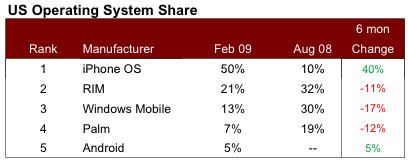
Meanwhile, the seminal Android-powered G1, built by HTC, has grown to 5 percent only three months after launch, the report says. These numbers don’t provide a comprehensive window into the smartphone web and app market — Admob is just adding up requests that its graphical and text ads receive due to mobile traffic on the more than 6,000 devices and 1,000 applications where they appear.
[aditude-amp id="flyingcarpet" targeting='{"env":"staging","page_type":"article","post_id":105507,"post_type":"story","post_chan":"none","tags":null,"ai":false,"category":"none","all_categories":"mobile,social,","session":"A"}']It’s hard to draw conclusions about this data because it doesn’t include other factors — like ad requests generated on devices by a range of competitors, ranging from Buzzcity to Yahoo. Except one can guess at what’s happening in the smartphone market due to the longer-term trends that Admob is seeing.
Android and iPhone usage has been trending up over the last half a year, the report says, while mobile web usage of devices powered by Nokia’s Symbian and Microsoft’s Windows Mobile operating systems hasn’t. In the U.S., the iPhone rose from 10 percent of the market last August to 50 percent last month, with Research in Motion’s BlackBerry devices dropping from 32 percent to 21 percent during the same period, Windows Mobile dropping from 30 to 13 percent and Palm dropping from 19 to 7 percent.
AI Weekly
The must-read newsletter for AI and Big Data industry written by Khari Johnson, Kyle Wiggers, and Seth Colaner.
Included with VentureBeat Insider and VentureBeat VIP memberships.
Losing market share is different from getting a smaller number of requests. RIM, for example, sent 48 percent more requests to Admob over the last six months — just not as many as the iPhone, so relatively, it was still going down in share. Android, meanwhile, has already risen to 5 percent of the market since it launched three months ago — and that’s with only one device. As more (and better) Android models emerge, expect this trend to continue.
Symbian is going open-source to try to attract more third-party application developers, like the developers currently helping to make the iPhone such an exciting device. Nokia and Microsoft are also launching app stores later this year. Can these companies appeal to their large user bases around the world? Android has already been getting a lot of attention specifically in China because its many device manufacturers are tired of paying and working around historically closed systems like Symbian and Windows. Plus, the country already has millions of unlocked iPhones floating around, and the long-rumored introduction of iPhone to China is looking closer than ever. For Nokia, Microsoft and Palm, the clock has already been ticking.
VentureBeat's mission is to be a digital town square for technical decision-makers to gain knowledge about transformative enterprise technology and transact. Learn More
